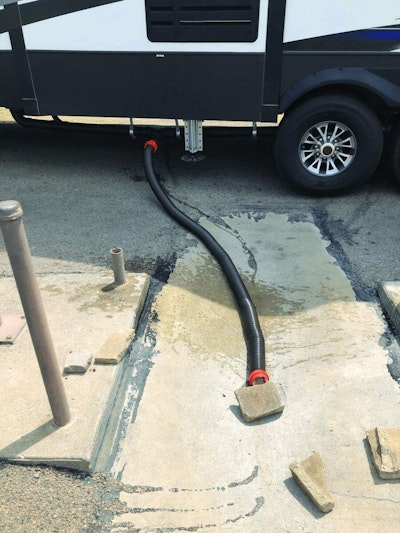Interested in Onsite Systems?
Get Onsite Systems articles, news and videos right in your inbox! Sign up now.
Onsite Systems + Get AlertsOver the last few years sales of recreational vehicles have been through the roof, which has led to many questions about where the waste collected in the holding tanks should go. The easy solution is to drop it off at a dump station and go on your merry way, but there are times when your customers may want to add this to their septic system.
It may be that they have an RV or have family and friends stopping by with their RV, which happens to have full tanks of black and graywater. An RV dump station at home can provide a convenient and cost-effective solution for RV owners. However, there are two challenges with adding this waste to septic systems.
First off, the wastewater is very concentrated due to the lack of graywater — most of the fixtures in RVs are low-flow to help stretch the clean water supply. Typical toilets only use 0.8 gpf and most RV showers operate at 2 gpm. Most RVs do not have a washing machine, and consequently experience a high level of organics and solids.
Secondly, most of the chemicals used to deodorize or break down the solids can add considerable challenges to treatment. Generally, people choose a holding tank product to eliminate odors, prevent clogs and waste buildup, and to keep sensors clean and working properly.
BEWARE OF ANTIMICROBIALS
In 2020, we did a study at the University of Minnesota testing four commercially available RV holding tank treatment products. All four products were found to be slightly acidic (ph range from 5.2 – 6.3). Microorganisms in septic systems prefer a neutral ph of 6.5-7.5. One of the products evaluated contained bronopol, a wide-spectrum antimicrobial product. Adding antimicrobial products into a septic system should be limited as the beneficial bacteria are needed throughout our systems for them to function properly.
In addition, when lab-tested, this product added an additional 55 mg/L of oxygen demand to the system. Another product tested contained both formaldehyde and methyl alcohol. Methyl alcohol has a very strong odor, which will mask the odor from the toilet waste. Formaldehyde is used most often in embalming and also as glue in building materials. It is added to holding tank additives to kill bacteria which is not a good thing for septic systems.
In addition, this product added 1,200 mg/L of BOD5 to the system and nearly 60 mg/L of phosphorus! If these chemicals are used in the RV, the waste could have a detrimental impact on a septic system.
Other products are typically enzyme or mineral based. Although these products are generally not as harmful for septic systems, they are generally not as effective at eliminating odor (enzymes) and preventing clogs and waste buildup (mineral based). RV blackwater tanks containing these chemicals have the risk of overloading the septic system with solids and negatively impacting the biological environment of the septic tank.
In another small study done at two state parks dump stations, the effluent leaving septic tanks was off the charts with its loading. The BOD5 at the two parks ranged from 1280-1530 mg/L, the total suspended solids from 92-230 mg/L and nitrogen levels from 757-769 mg/L. These nitrogen levels are very high compared as other sources of wastewater — primarily toilet flushing — which are typically less than half of these values. These parks have advanced commercial pretreatment systems designed to handle the higher load from RVs.
DUMPING VOLUME
The last issue to consider is the volume and method of conveying RV waste to residential septic systems. The amount will vary as larger RVs generally have larger tanks. Typically, graywater tanks will hold 30 to 50 or more gallons, and the backwater tank is typically 20-40 or more gallons. This could add more than 100 gallons of concentrated wastewater to the treatment system.
Adding these concentrated waste streams at one time into the septic tank may cause turbulence and overloading. The use of a pump to add the waste to the septic system should be avoided as it will macerate the solids into smaller pieces that will not settle well and will add the wastewater at a higher velocity. Since the goal of additives is to break down the waste into smaller pieces so they can be more easily evacuated from the RV, this also can lead to solids that would not settle well.
Taking all of these concerns into consideration, if a property owner still wants to add their RV waste to a system here are the critical items:
- Do not use RV chemicals.
- Do not dispose of anything other than human waste, toilet paper and water into the system.
- Depending on use, the septic tank may need to be pumped more frequently due to the increased concentrated load.
- The wastewater should be slowly added to the system ideally through a clean-out near the house versus directly into the septic tank to prevent turbulence.
Another option to consider is a holding tank exclusively used for the RV waste. This holding tank is pumped when it fills and the septic system is protected.









